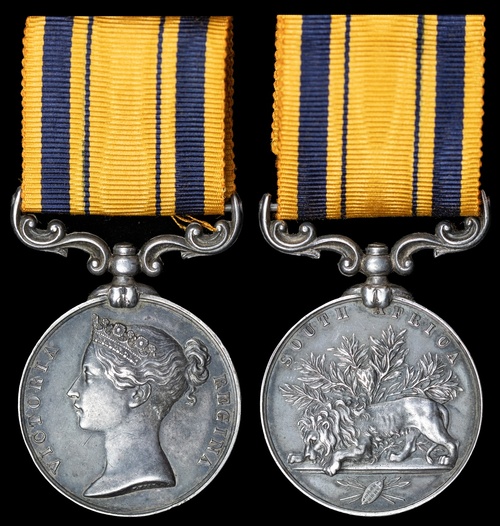
Auction: 25001 - Orders, Decorations and Medals
Lot: 226
Carbutts Border Rangers
Captain Thomas Carbutt, a farmer near Ladysmith with previous military experience in the Natal Frontier Guard that had been disbanded in 1876, responded to the call and began to recruit volunteers from among the local settler community for the defence of Colonial Defensive District No. 1. His 30 men wore their everyday clothes and carried their own weapons.
On 22 January 1879 the disaster of Isandhlwana took place, an incident that shocked the British people and establishment to the very core. A day or so after the battle the survivors and those that had missed the battle were holed up at Rorke’s Drift or at Helpmekaar. The only Regiment in central Natal thus carrying out its duties was Carbutt’s Border Rangers. The Port Elizabeth Herald gives more detail:
'His Excellency the Governor General has been pleased to accept the services of several of the inhabitants of Klip River country, who have offered themselves into a corps for the purpose of protecting the district.'
Once equipped and mounted the Rangers patrolled the Waschbank Valley, the Sundays River drifts and the approaches to Ladysmith but after the massacre at Isandhlwana they extended their area of operation. They arrived at Rorke’s Drift five days after the battle to find Lieutenant Chard, who had been in command, very ill and in need of medical attention. They escorted him back to Ladysmith where he was nursed back to health. Once in the field the Rangers commandeered a deserted homestead on the farm Doornkraal, between Ladysmith and the Sundays River, as their headquarters and it was reported that a troop of Natal Mounted Police who spent the night there on 20 February found Carbutt’s Rangers dining on “their habitual diet of rum and dampers” – unleavened cakes cooked in the ashes of a fire – and living up to their nickname of the “Blind Owls”
Early in April the Rangers moved to their new camp at Dundee where it is recorded that they were 30 strong on 14 April. Recruiting continued and their number rose to 37. They operated between Dundee and Landman’s Drift and later marched to Rorke’s Drift where they assembled with the other troops brought together to bury the Isandlwana dead. The column crossed the Buffalo River en route for the deserted battlefield on 21 May 1879. At the scene the Rangers found the body of a Wagon Conductor, Phillipe Du Bois, who was well known to all the troop. They took the body to his farm at Helpmekaar for burial. (AngloBoerWar.com refers).
23 Medals, all without clasp, issued to this unit.
South Africa 1877-79, no clasp (Qr. Mr. Burchmore. Carbutts. Br. Rangers.), unofficially engraved naming, very fine
Name not on roll.
Subject to 20% VAT on Buyer’s Premium. For more information please view Terms and Conditions for Buyers.
Estimate
£140 to £180
Starting price
£110




